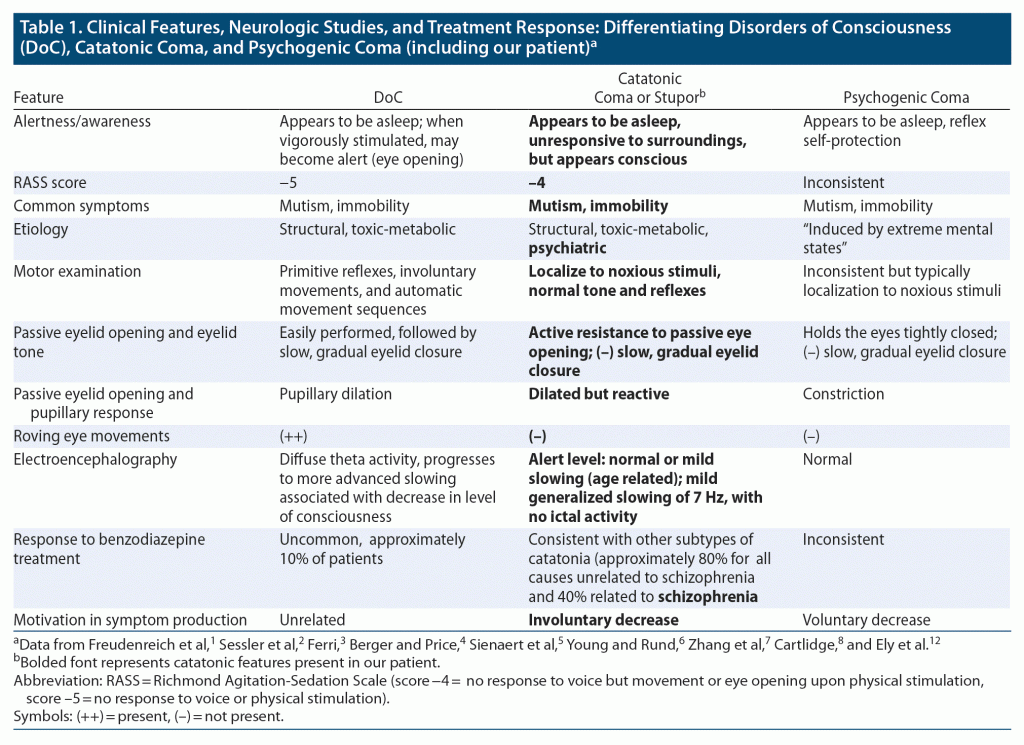
Prim Care Companion CNS Disord 2023;25(1):22cr03301
To cite: Spiegel DR, Ayzman A, Reid FE, et al. Catatonic coma in a patient with schizophrenia receiving palliative care with reversal of symptoms with lorazepam. Prim Care Companion CNS Disord. 2023;25(1):22cr03301.
To share: https://doi.org/10.4088/PCC.22cr03301
© 2023 Physicians Postgraduate Press, Inc.
aDepartment of Psychiatry and Behavioral Sciences, Eastern Virginia Medical School, Norfolk, Virginia
*Corresponding author: David R. Spiegel, MD, Eastern Virginia Medical School, Department of Psychiatry and Behavior Sciences, 825 Fairfax Ave, Norfolk, VA 23507 ([email protected]).
Patients with disorders of consciousness (DoC) in the form of stupor or coma typically suffer from medical or neurologic illnesses. While uncommon, catatonia can manifest with dramatic unresponsiveness, yet with minimal ancillary symptoms. These cases of catatonic coma (CC) are nevertheless important to identify, as treatment with intravenous benzodiazepines is highly effective.1 We present the case of a patient with CC, which precipitated a palliative care consult; however, full-dose lorazepam challenge changed this patient’s clinical course.
Case Report
The patient was a 71-year-old woman who presented to the emergency department with altered mental status of 1 week duration. On initial evaluation, the patient was mute and did not open her eyes. Collateral history indicated a prior diagnosis of schizophrenia with unknown adherence to aripiprazole. Medical evaluation was remarkable solely for starvation ketosis. Urinalysis, infectious serologies, and chest x-ray were negative, and both computed tomography and magnetic resonance imaging of the head demonstrated no acute findings. Her blood alcohol level and urine drug screen were negative. The starvation ketosis was treated; however, 3 days later the patient’s mental status had not changed. The consultation psychiatry service was consulted at this time.
On evaluation, the patient’s Richmond Agitation-Sedation Scale (RASS)2 score was –4 (Table 1).3–8 Her Bush-Francis Catatonia Rating Scale (BFCRS)9 score was 12. The next day, hospital day 7, lorazepam challenge 0.5 mg intravenous (due to advanced age and body mass index of 19 kg/m2) was administered with no change in BFCRS score. Due to the patient’s medical frailty and concerns of respiratory depression, a rechallenge was not performed.
Ultimately, due to this prolonged state of stupor, a palliative care consult was initiated. At this time, 10 days after the initial lorazepam challenge, lorazepam 1 mg intravenous was administered. Her BFCRS score decreased 2 points after 5 minutes. Thus, with the patient’s vital signs stable, a second dose of lorazepam 1 mg intravenous was administered. Within 5 minutes, her BFCRS score decreased to 4. Lorazepam was titrated to 2 mg 3 times/d. After 1 week, her BFCRS score was 1, and aripiprazole was administered. Lorazepam taper was started. Three weeks after our initial consultation, the patient was discharged on lorazepam 1 mg 3 times/d with aripiprazole lauroxil.
Discussion
One clinical challenge in our patient with CC is that staring, reported to be present in 75% of patients with hypokinetic catatonia,10 was not present, and both eyes remained closed. Thus, the first step of evaluating a patient with stupor or coma is to objectively quantify this state. A structured arousal scale, such as the RASS, is a reliable method to describe DoC.11 RASS scores of −4 (as in our patient) or −5 indicate stupor and coma/CC, respectively.12 For simplicity, we are subsuming CC to include those with RASS scores of −4 to –5.
After an unremarkable medical/neurologic evaluation, combined with our patient’s history of schizophrenia and results as shown in Table 1, our differential diagnosis broadened to include CC and psychogenic coma. Notably, the electroencephalogram (EEG) is abnormal in over 43% of patients with catatonia but is less likely to be abnormal in patients with a history of psychiatric illness.1 Toward this end, our patient’s EEG (7 Hz) demonstrated a mild encephalopathy. Given our patient’s RASS score, if medical/neurologic–induced stupor or coma was etiologic, we would suspect that the degree of slowing on the EEG would have been more pronounced.13 Therefore, we reconsidered a diagnosis of CC due to schizophrenia, especially with a positive response to the lorazepam 1 mg rechallenge.14 Interestingly, a small subset of patients with DoC respond not only to benzodiazepines but also to zolpidem, a γ-aminobutyric acid-A receptor agonist, selectively at α1 subunits.15
As demonstrated, lorazepam may have a life-changing impact on patients with CC.7 Thus, in patients with DoC, coma should always be considered first, because it requires timely intervention. Nonetheless, clinicians need to consider CC in this intriguing phenotype.16
Published online: February 2, 2023.
Relevant financial relationships: Dr Spiegel is in the speaker’s bureau for Allergen, Alkermes, Otsuka, and IntraCellular but has no conflict of interest in preparation of this manuscript. Mss Ayzman, Reid, and Ahuja and Mr Worfolk have no conflicts of interest to report.
Funding/support: None.
Patient consent: Consent was verbally received from the patient to publish the case report, and information has been de-identified to protect anonymity.
References (16)

- Freudenreich O, McEvoy JP, Goff DC, et al. Catatonic coma with profound bradycardia. Psychosomatics. 2007;48(1):74–78. PubMed CrossRef
- Sessler CN, Gosnell MS, Grap MJ, et al. The Richmond Agitation-Sedation Scale: validity and reliability in adult intensive care unit patients. Am J Respir Crit Care Med. 2002;166(10):1338–1344. PubMed CrossRef
- Ferri F. Ferri’s Clinical Advisor 2022. Philadelphia, PA: Elsevier; 2022:1816–1819.
- Berger JR, Price R. Stupor and Coma. In Jankovic J, Mazziotta JC, Pomeroy SL, et al. Bradley and Daroff’s Neurology in Clinical Practice. 8th ed. Elsevier; 2021:34–52.
- Sienaert P, Dhossche DM, Vancampfort D, et al. A clinical review of the treatment of catatonia. Front Psychiatry. 2014;5:181. PubMed CrossRef
- Young JL, Rund D. Psychiatric considerations in patients with decreased levels of consciousness. Emerg Med Clin North Am. 2010;28(3):595–609. PubMed CrossRef
- Zhang B, O’Brien K, Won W, et al. A retrospective analysis on clinical practice-based approaches using zolpidem and lorazepam in disorders of consciousness. Brain Sci. 2021;11(6):726. PubMed CrossRef
- Cartlidge N. States related to or confused with coma. J Neurol Neurosurg Psychiatry. 2001;71(suppl 1):i18–i19. PubMed
- Bush G, Fink M, Petrides G, et al. Catatonia, I: rating scale and standardized examination. Acta Psychiatr Scand. 1996;93(2):129–136. PubMed CrossRef
- Worku B, Fekadu A. Symptom profile and short-term outcome of catatonia: an exploratory clinical study. BMC Psychiatry. 2015;15(1):164. PubMed CrossRef
- Han JH, Wilber ST. Altered mental status in older patients in the emergency department. Clin Geriatr Med. 2013;29(1):101–136. PubMed CrossRef
- Ely EW, Truman B, Shintani A, et al. Monitoring sedation status over time in ICU patients: reliability and validity of the Richmond Agitation-Sedation Scale (RASS). JAMA. 2003;289(22):2983–2991. PubMed CrossRef
- de Waal H, Stam CJ, Blankenstein MA, et al. EEG abnormalities in early and late onset Alzheimer’s disease: understanding heterogeneity. J Neurol Neurosurg Psychiatry. 2011;82(1):67–71. PubMed CrossRef
- Fink M. Catatonia: syndrome or schizophrenia subtype? recognition and treatment. J Neural Transm (Vienna). 2001;108(6):637–644. PubMed CrossRef
- Noormandi A, Shahrokhi M, Khalili H. Potential benefits of zolpidem in disorders of consciousness. Expert Rev Clin Pharmacol. 2017;10(9):983–992. PubMed CrossRef
- Ryznar E, Wilcox D. Functional coma: two case reports and a review of the literature. Psychosomatics. 2019;60(4):343–351. PubMed CrossRef
Please sign in or purchase this PDF for $40.
Save
Cite





